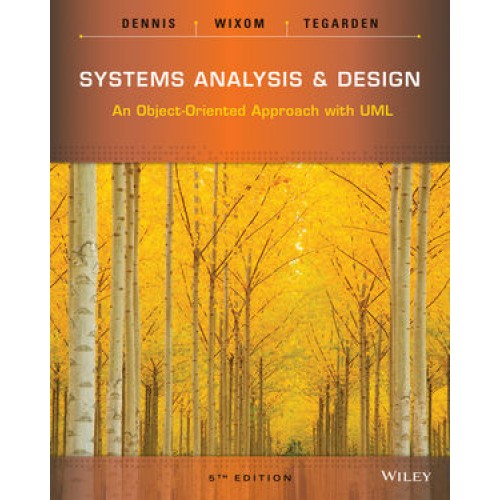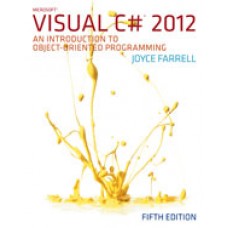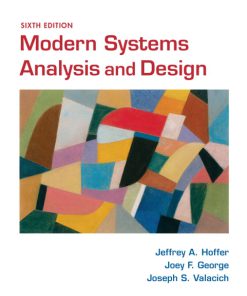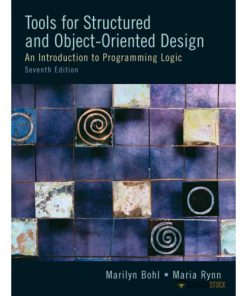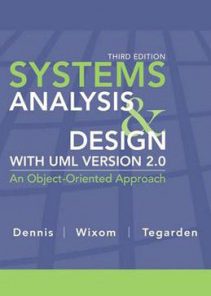Test Bank for Systems Analysis and Design: An Object-Oriented Approach with UML, 5th Edition by Dennis, Wixom, Tegarden
$35.00 Original price was: $35.00.$26.50Current price is: $26.50.
Test Bank for Systems Analysis and Design: An Object-Oriented Approach with UML, 5th Edition by Dennis, Wixom, Tegarden
Test Bank for Systems Analysis and Design: An Object-Oriented Approach with UML, 5th Edition by Dennis, Wixom, Tegarden

Product details:
- ISBN-10 : 1118804678
- ISBN-13 : 978-1118804674
- Author: Dr. Alan R. Dennis
Systems Analysis and Design: An Object-Oriented Approach with UML, 5th Edition by Dennis, Wixom, and Tegarden captures the dynamic aspects of the field by keeping students focused on doing SAD while presenting the core set of skills that every systems analyst needs to know today and in the future.
The text enables students to do SAD—not just read about it, but understand the issues so they can actually analyze and design systems. The text introduces each major technique, explains what it is, explains how to do it, presents an example, and provides opportunities for students to practice before they do it for real in a project. After reading each chapter, the student will be able to perform that step in the system development process.
Table contents:
Chapter 1 Introduction to Systems Analysis and Design 1
Introduction 1
Typical Systems Analyst Roles and Skills 2
Business Analyst 3
Systems Analyst 3
Infrastructure Analyst 3
Change Management Analyst 3
Project Manager 4
The Systems Development Life Cycle 4
Planning 5
Analysis 5
Design 6
Implementation 6
Systems Development Methodologies 7
Structured Design 7
Rapid Application Development (RAD) 9
Object-Oriented Systems Analysis and Design (OOSAD) 11
Agile Development 13
DevOps 16
Custom Methodologies 17
The Unified Process 17
Phases 18
Workflows 20
Extensions to the Unified Process 22
The Unified Modeling Language 26
Applying the Concepts at Patterson Superstore 28
Chapter Review 28
Key Terms 28
Questions 29
Exercises 30
Minicases 30
Appendix Basic Characteristics of Object-Oriented Systems 32
Classes and Objects 32
Methods and Messages 33
Encapsulation and Information Hiding 34
Polymorphism and Dynamic Binding 34
Inheritance 36
Appendix Review 39
Key Terms 40
Questions 40
Exercises 40
Chapter 2 Project Management 41
Introduction 41
Project Identification 43
System Request 44
Feasibility Analysis 45
Technical Feasibility 45
Economic Feasibility 46
Organizational Feasibility 51
Project Selection 53
Ethical Considerations 54
Traditional Project Management Tools 55
Work Breakdown Structures 55
Gantt Chart 57
Network Diagram 57
Project Effort Estimation 60
Creating and Managing the Workplan 65
Evolutionary Work Breakdown Structures and Iterative Workplans 65
Managing Scope 69
Timeboxing 70
Refining Estimates 71
Managing Risk 72
Agile Alternatives to Iterative Workplans 73
Staffing the Project 74
Tuckman’s Stages of Small Group Development 74
Characteristics of a Jelled Team 75
Staffing Plan 76
Motivation 79
Handling Conflict 80
Meeting Management 81
Environment and Infrastructure Management 83
CASE Tools 83
Standards 83
Documentation 84
Configuration and Change Management 85
Applying the Concepts at Patterson Superstore 87
Chapter Review 87
Key Terms 88
Questions 88
Exercises 89
Minicases 90
Part One Analysis Modeling 93
Chapter 3 Requirements Determination 95
Introduction 95
Requirements Determination 96
Defining a Requirement 96
Real-World Problems with Requirements Determination 98
Requirements Analysis Approaches 99
Problem Analysis 99
Root Cause Analysis 100
Duration Analysis 100
Activity-Based Costing 102
Informal Benchmarking 102
Outcome Analysis 102
Technology Analysis 103
Activity Elimination 103
Requirements-Gathering Techniques 103
Interviews 104
Questionnaires 108
Observation 111
Document Analysis 112
Selecting the Appropriate Techniques 113
Text Analysis 115
Requirements Definition 117
Creating a Requirements Definition 117
User Stories 119
The System Proposal 120
Applying the Concepts at Patterson Superstore 121
Chapter Review 122
Key Terms 122
Questions 122
Exercises 123
Minicases 124
Chapter 4 Business Process and Functional Modeling 126
Introduction 126
Business Process Identification with Use Cases and Use-Case Diagrams 128
Types of Use Cases 129
Elements of Use-Case Diagrams 130
Identifying the Major Use Cases 134
Creating a Use-Case Diagram 135
Business Process Modeling with Activity Diagrams 138
Elements of an Activity Diagram 139
Guidelines for Creating Activity Diagrams 143
Creating Activity Diagrams 145
Business Process Documentation with Use-Case Descriptions 148
Elements of a Use-Case Description 149
Guidelines for Creating Use-Case Descriptions 152
Creating Use Case Descriptions 153
Verifying and Validating the Business Processes and Functional Models 160
Verification and Validation through Walkthroughs 160
Functional Model Verification and Validation 161
Applying the Concepts at Patterson Superstore 163
Chapter Review 164
Key Terms 164
Questions 164
Exercises 165
Minicases 167
Chapter 5 Structural Modeling 169
Introduction 169
Structural Models 170
Classes, Attributes, and Operations 170
Relationships 171
Object Identification 172
Textual Analysis 173
Brainstorming 173
Patterns 175
CRC Cards 178
Responsibilities and Collaborations 178
Elements of a CRC Card 179
Role-Playing CRC Cards with Use Cases 180
Class Diagrams 181
Elements of a Class Diagram 181
Simplifying Class Diagrams 190
Object Diagrams 190
Structural Models Using CRC Cards and Class Diagrams 191
Campus Housing Example 193
Library Example 193
Verifying and Validating the Structural Model 200
Balancing Functional and Structural Models 203
Applying the Concepts at Patterson Superstore 206
Chapter Review 206
Key Terms 206
Questions 207
Exercises 207
Minicases 209
Chapter 6 Behavioral Modeling 211
Introduction 211
Behavioral Models 212
Interaction Diagrams 213
Objects, Operations, and Messages 213
Activity Diagrams 213
Sequence Diagrams 215
Creating a Sequence Diagram 223
Crude Analysis 230
Campus Housing Example 231
Library Example 232
Behavioral State Machines 232
States, Events, Transitions, Actions, and Activities 232
Elements of a Behavioral State Machine 234
Guidelines for Creating Behavioral State Machines 238
Creating a Behavioral State Machine 238
Campus Housing Example 239
Library Example 240
Verifying and Validating the Behavioral Model 241
Balancing Functional and Behavioral Models 242
Balancing Structural and Behavioral Models 244
Applying the Concepts at Patterson Superstore 248
Chapter Review 248
Key Terms 248
Questions 249
Exercises 249
Minicases 251
Part Two Design Modeling 253
Chapter 7 Moving on to Design 255
Introduction 255
Verifying and Validating the Analysis Models 257
Evolving the Analysis Models into Design Models 257
Factoring 258
Partitions and Collaborations 258
Layers 259
Packages and Package Diagrams 263
Guidelines for Creating Package Diagrams 265
Creating Package Diagrams 266
Verifying and Validating Package Diagrams 268
Design Criteria 270
Coupling 271
Cohesion 273
Connascence 274
Design Strategies 275
Custom Development 275
Packaged Software 276
Outsourcing 277
Selecting a Design Strategy 279
Selecting an Acquisition Strategy 280
Alternative Matrix 281
Applying the Concepts at Patterson Superstore 282
Chapter Review 283
Key Terms 283
People also search:
essentials of systems analysis and design 5th edition
systems analysis and design 5th edition
systems analysis and design 5th edition year
systems analysis and design in a changing world 5th edition
You may also like…
Solution Manual
Test Bank
Test Bank for Tools For Structured and Object-Oriented Design, 7/E 7th Edition : 0131194453
Solution Manual
Systems Analysis and Design 6th Edition Dennis Solutions Manual


